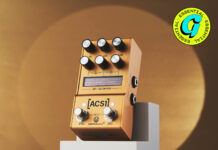
Answered: Technical Guitar Questions You Were Too Afraid To Ask
For most of us, learning guitar is a labor of love, and that love is placed squarely in the music we want to make with the instrument, not necessarily in how it works and functions as a piece of equipment. In this article, or perhaps series of articles, we’ll take a look at some of those steps that might get overlooked when it comes to getting to understand our instruments and how they work.
READ MORE: The best electric guitars for metal – our top-rated Jacksons, Gibsons, Strandbergs & more
How Do I Tune A Guitar With A Tuner (Properly)?
Tuning a guitar seems like it would be the easiest thing in the world for a guitarist to learn, but there is actually a fair amount of subtlety to it if done properly. Everyone should learn to tune by ear, and there are enough tutorials online on how to do that. I do have some tips for those using a tuner of some sort that will help you get a better reading.
A guitar string vibrating consists of several notes – there’s the fundamental note, which is the initial sound when you pluck the string. Your fundamental note is the lowest note and then you have harmonics of that note at various points on the string. We know exactly where these points are, and they are very important in determining the timbre of an instrument. However, these harmonics often confuse a tuner – that’s why your tuner might bounce around a bit before it “settles down” and gives you a good reading.
When tuning your guitar, you only want the fundamental note, which happens to be the lowest note, so, to make it easier for the tuner to find that, roll the tone knob down very low, switch your guitar to the neck or rhythm pickup (if it has one) and then pluck the string over the twelfth fret. Don’t pluck it too hard or your string will go sharp and by the time it settles down, the note has died out – this is especially true on down-tuned guitars. Light pluck is all you need. This will give you the most accurate reading on a tuner.
What Does A Tone Knob Actually Do?
Most guitars have volume knobs and tone knobs, and while the volume knobs are fairly self-explanatory, ‘Tone’ knobs are a bit more misunderstood. Tone is a big buzz word in the guitar community and there are a million different ways that a guitarist can alter their tone, only one of which is the knob on the guitar. As it turns out, the tone knob affects the tone in a very specific way and can be a very important tool for us to alter tone before it leaves the output jack of our guitar.
The tone knob on your guitar is essentially a low-pass filter which allows lower frequencies to pass through the pot while knocking out the high frequencies. So, when you find your tone a bit harsh and high pitched, you can roll back on your tone knob to knock out some of those high frequencies. It functions very similarly to a treble knob on an amplifier.
When your tone knob is set to 10, you are letting all frequencies through, and you can dial it down until it’s at 0, at which point no frequencies will get through, and the guitar will not have any output. Learning to work with your tone knob will allow you to dial in a wider range of sounds right on your instrument without having to go mess with your amp during a show.
Are Neck And Bridge Pickups Interchangeable?
Most of the time, pickups will physically fit into either position on the guitar, but a good life lesson is: just because it fits doesn’t necessarily mean you should put it in there. There are some key differences that you should be aware of.
The first difference is that bridge and neck pickups are often wound differently. A string vibrates differently at the neck pickup than it does at the bridge. The string vibrates less at the bridge because it’s closer to a fixed point. Many builders compensate for this by making the bridge pickup “hotter”, essentially boosting the signal to match the neck pickup’s output signal.
The other key difference is string spacing. The string spacing at the bridge and the nut is generally different on electric guitars, with the string spacing being narrower at the nut than at the bridge. Because of this, the pole spacing on the neck pickup is often closer together than on the bridge pickup. This is not always the case, but oftentimes it is. Today, many aftermarket pickups make “F-Spaced” humbuckers, which can be used in Fenders as the string spacing on a Fender is usually a bit narrower than on a Gibson. Eddie Van Halen compensated for this difference on his Frankenstrat by slanting the humbucker to put the pole pieces more directly under the strings on his Fender-style guitar.
With these differences in mind, my advice is always to try anything that you feel might give you the sound you are looking for. Experimentation is just fine. I swap pickups all the time, and sometimes it has yielded really good results. Remember, you can always swap them back.
Why Do Some Guitars Have A Stripe On The Back Of The Neck and Some Don’t?
This is referred to as a “skunk stripe,” and it is most commonly found on Fender guitars. It was originally seen on guitars where the neck and fretboard were one piece of wood. In these cases, the truss rod was inserted from the back of the neck and the hole was covered with a piece of wood that was usually a different color. This was done because using a piece of the same color maple would have made it look as if a repair had taken place. So, they opted to make it ornamental instead, using walnut prior to 1959 and today it can be anything (I usually use roasted maple).
Fender still uses a skunk stripe today, even when the neck is a two-piece design and the truss rod can be easily inserted into the neck before the fretboard is glued on. The skunk stripe has become somewhat of a marketing gimmick for people who have become accustomed to it.
Got your own question about guitar that you were too afraid to ask? Email editors@guitar.com and the answer might appear in a future article…
The post Answered: Technical Guitar Questions You Were Too Afraid To Ask appeared first on Guitar.com | All Things Guitar.
Source: www.guitar-bass.net













